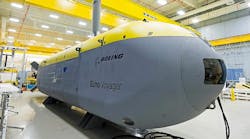Boeing moves forward in unmanned submersible mothership project to deploy unmanned surveillance
ARLINGTON, Va. –Unmanned underwater vehicle (UUV) designers at the Boeing Co. are continuing their work to develop enabling technologies for a large unmanned submersiblemothership able to transport and deploy unmanned aerial vehicles (UAVs and UUVs stealthily close to enemy operations.
Unmanned vehicles designers at the U.S. Defense Advanced Research Projects Agency (DARPA) in Arlington, Va., announced a $7.6 million contract modification Friday to the Boeing Defense, Space & Security segment in Huntington Beach, Calif., for continued support of the DARPA Hydra phase 2 program.
The Hydra project seeks to demonstrate an unmanned undersea system with a new kind of unmanned-vehicle delivery system that inserts UAVs and UUVs stealthily into operational environments to respond quickly to situations around the world.
The DARPA Hydra large UUV program has been in progress for nearly three years, and involves the Boeing Co. Defense, Space & Security segment in Huntington Beach, Calif., and Hydroid Inc. in Pocasset, Mass.
Hydra aims to develop a distributed undersea network of UUVs and UAVs able to operate independently for weeks or months at a time to complement manned ships, submarines, and aircraft as an alternate means of delivering various capabilities above, on, and below the ocean’s surface.
Related: Military research projects may be coming together to put large long-endurance UUVs in sight
Independently, Boeing has developed the Echo Voyager, a 51-foot large UUV that can reach depths of 11,000 feet and can operate independently for months underwater. Boeing unveiled the Echo Voyager one year ago and began sea trials of the unmanned undersea craft last summer.
story continues below
Key to the Hydra project is developing modular payloads for intelligence, surveillance, and reconnaissance (ISR); mine counter-measures (MCM); and other important capabilities.
The Hydra large UUV is to use modular payloads inside a standardized enclosure to deploy a mix of UAVs and UUVs, depending on the military situation. Hydra will integrate existing and emerging technologies in new ways to create an alternate means of delivering a variety of payloads close to where they're needed, DARPA officials say.
The Hydra program aims at demonstrating not only the unmanned vehicle mothership, but also examples of the UAVs and UUVs that could be carried into battle covertly.
The rising number of ungoverned states, piracy, and proliferation of sophisticated defenses severely stretches current resources and influences U.S. military capability to conduct special operations and contingency missions, DARPA scientists say.
Related: DARPA asks industry for large unmanned undersea vehicle advanced payload delivery system
The Hydra program may represent a way to add undersea capacity that can be tailored to support each mission. Technologies are to be adaptable to several different delivery options, including airborne, surface, and subsurface. The Hydra program could enable other new capabilities not currently performed from undersea, DARPA officials say.
The first phase of the DARPA Hydra project focused on design and technology demonstration of modular submersible enclosures; deployable UAVs; deployable UUVs; deployment and retrieval of using a variety of platforms; and related technologies.
The second phase is concentrating on building a complete modular enclosure; a complete air vehicle payload module; a complete undersea payload module with several undersea vehicles and interfaces with the modular enclosure module; and demonstrating these modules in a realistic environment.
Modular enclosure subsystems include ballast system, energy, communications, command and control, propulsion, the ability to accommodate different payloads, and measures for long-duration submerged operations.
Related: Navy Knifefish unmanned underwater vehicle (UUV) finds mines in undersea drone test
The deployable UAV portion features encapsulated air vehicles that fit into the standard Hydra modular enclosure. The air vehicle payload will eject from the mothership, float to the surface, launch, fly a minimum range, and conduct several different types of missions.
Undersea payloads will launch, dock, and recharge from the mothership and collect intelligence information. After their missions they will download information to the mothership, which will communicate it to command authorities.
On this contract modification Boeing will do the work in Huntington Beach, Santa Fe Springs, Anaheim, Long Beach, Placentia, and Garden Grove, Calif., as well as in Attleboro, Mass., and should be finished by January 2019.
For more information contact Boeing Defense, Space & Security online at www.boeing.com/company/about-bds, or DARPA at www.darpa.mil.
Learn more: search the Aerospace & Defense Buyer's Guide for companies, new products, press releases, and videos

